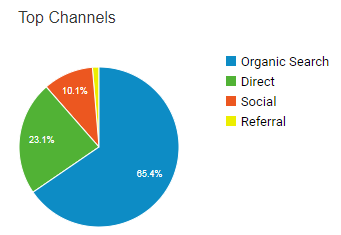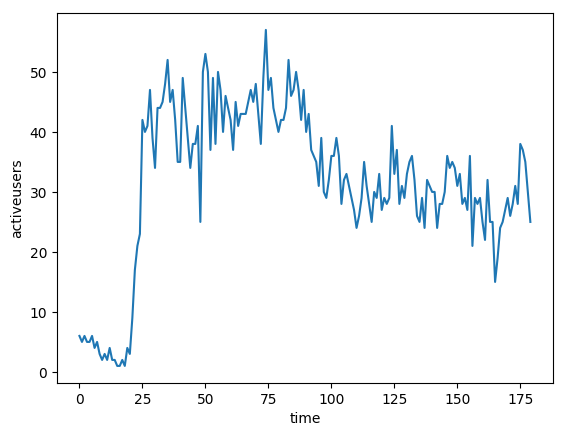|
GoatFormat.com's first post was on 10/7/2018, which means that it's been about 6 months since we started the difficult task of building the first website that was comprehensively dedicated to Goat Format Yu-Gi-Oh! One of my biggest personal values is honesty, and transparency is closely linked with honesty. Hence, I hope to make one of these "State of GoatFormat.com" posts about every 6 months to address our challenges and our successes in order to show the community the path that we are headed on for the future. Read on for some cool metrics, insight into our thought process, and plans for the future. Beware: This is a long read.
People Are Checking Out Goats
Around mid-2018, I was worried that Goat Format was losing momentum and that interest for the format was dying out. Anyone who knows me well knows that I'm naturally a pessimist. I'd probably call myself a "realist", but as I like to say, a realist is just a pessimist who's right a lot. In this case, however, my pessimism was unfounded. By at least one key measure, interest in Goat Format is at an all-time high.
The graph above shows that as time has passed, more and more people have been sticking "goat format" into their google search and hitting enter. This is good news for the Goat Format community as a whole, as well as GoatFormat.com. We don't need to necessarily convince people that Goat Format is interesting; interest is organically growing without any intervention.
Google Is Our Friend
Search engine optimization (SEO) has been a big priority of ours, and we enlisted an SEO expert, Anteaus, in order to ensure that GoatFormat.com was formatted in a way that would maximize our exposure in search engines. So how much of our traffic comes from search engines? More than you probably think.
Surprisingly enough, about 2/3 of our traffic comes from search engines. What sort of phrases are these people searching for?
About 8% of our overall traffic comes from one specific search term: goat format. This should not be surprising, as we are in fact GoatFormat.com. However, we need to keep in mind who our customers are. What kind of person do you think is entering "goat format" into their search bar? If You're Good At Goat Format, You're A Minority
When we started GoatFormat.com, one of the things that I strongly pushed for was having a site that catered to newbies: people with little to no experience playing the format. Admittedly, this push was more based on my vision than anything else. Experienced players don't need very much help; that's why they're called "experienced." In order for the Goat Format community to be sustainable in the long term, I knew that we would need a constant flow of new players to replace those that left the community for whatever reason. Creating a website that could serve as a guide for newer players would do a lot more social good than focusing on creating a hangout space for Goat Format "intellectuals" (for lack of a better term).
Unsurprisingly, this focus on newer players turned out to be a great business decision as well. If you look above at those search terms, these are clearly phrases that newer Goat Format players would be interested in. Someone who's been playing the format for five years is not google searching for terms like "goat format card pool" or "goat format banlist." In fact, I'd wager that they aren't really google searching any Goat Format related terms at all. Investigating our most viewed pages confirms the hypothesis that our customers are mostly newbies. By the Pareto principle, "the law of the vital few," we'd assume that about 80% of our traffic comes from about 20% of our pages. This turns out to be a correct assumption. But which 20% is the vital few? Obviously, our home page is the most visited page. However, the most popular pages after that might surprise you. Our Card Pool & Ban List page is by far the most popular, at more than 10% of our overall traffic. This is clearly a page that is helpful for newer players. Our second most popular page? The Tier List page. This is a great resource for newer players, and it is also a feature that GoatFormat.com is the sole provider of. No other website on the internet can give you a quick snapshot of the Goat Format metagame sorted by popularity. These two traits, "helpful for newbies" and "unique/original", are what I believe to form the sweet-spot that will be the jet fuel for GoatFormat.com's continued growth. With that in mind, can you guess what our most popular strategy article was? It's Fusions in Goat Format. This topic was suggested to us by some newer players, and it's been viewed more than nearly every other strategy article combined. Building a fusion deck is essential for any player that's new to Goat Format, and no other site was helping people do this! Addressing The Thunder Dragon In The Room
Every once awhile, I find a few experienced Goat Format players who seem to have a bone to pick with our choice to classify a deck as "Thunder Dragon Chaos." They would prefer to have the list with Morphing Jar/Cyber Jar classified as "Chaos Turbo", and the list with Scapegoat/Metamorphosis lumped together with Chaos Control. Ultimately, this would not make much sense on a classification theory basis, as decks are most logically classified on the dual axis of aggression and synergy, and both Thunder Dragon Chaos variants are low-aggression, high-synergy decks, whereas Chaos Control is a low-aggression, low-synergy deck. But at the risk of going off on long tangent into the science of classification, let's get to the real point.
Any good business is mostly going adopt a "the customer's right" attitude, and we've already established that our customers are mostly Goat Format newbies. So in regards on how to categorize our decks, I'm mostly going to have two key factors in mind: what the newbies like, and what's good for SEO. Here's what I've learned from newer players: They all understand what chaos is, even in the context of a format that they've barely played! They get that chaos decks play about 50% monsters and use Chaos Sorcerer as a means of winning the war of attrition. I've only spoken with one player who immediately wanted to classify Reasoning Gate Combo as being a "chaos" deck based on the decklist, because most people just don't think of a chaos deck as being built around complex combos even if it includes the card Chaos Sorcerer. However, when I asked newer players what they thought a deck called "Chaos Turbo" would look like, they immediately started envisioning some sort of OTK deck with Chaos monsters and Dimension Fusion or Return from the Different Dimension. Historically speaking, the word "turbo" has been applied to decks that look and act nothing like Thunder Dragon Chaos, which is why newer players are naturally confused by this term. Given the long trend of classifying decks using the engine+archetype naming convention, "Thunder Dragon Chaos" makes perfect sense to them. Now can you guess what our most popular deck guide is? It's Thunder Dragon Chaos, by a surprising margin (14% more popular than Goat Control). Searches for terms of "goat format thunder dragon" and "thunder dragon chaos" are far higher than searches for "chaos turbo" and similar. The good news is that our page is still ranked #7 in google search results for "chaos turbo," providing us with high visibility for either search term. Since we are the only website on the internet that provides a guide to the Goat Format deck called "Thunder Dragon Chaos," this is yet another example of the newbie/unique sweet-spot that we're looking for. Converting Interest Into Enthusiasm
Getting eyeballs is great, but that alone doesn't accomplish a whole lot. To use a retail analogy, suppose that you had a store in an area in which foot traffic was increasing. This would be great news! However, you'd want some of those people to walk into your store, and you'd want some of those people to buy something. Then you'd hope that those customers would return in the future to buy more products. While we're not selling any products (yet), I take a similar view. Our exposure is definitely increasing, but it's not translating into community growth as much as I'd like. Tackling this challenge is going to be a top priority for us moving forward.
Most of growth in new traffic is fueled through search engines, as you can see in the graph of our new users from search engines below: However, as more and more people have been exposed to our brand in some form, the number of active users on our discord server has not increased along with it (although the total number of members continues to increase). This is clear from the following activity graph. Note that the unit of time on the x-axis is days. Momentum is very important in the growth of an online community due to the important role that network externalities play. Our discord metrics are mostly going sideways right now, but if they don't start turning up, there's a real risk that they will begin to point down instead. What The Hell Is A Discord?
Most failures in business are founded upon a throne of false assumptions. I believe that I have already made one. This false assumption is that the people who are visiting our website understand what Discord is. After delving into our metrics, I came to the conclusion that this assumption cannot possibly be correct. Why? About 73% of our total users have clicked on our animated advertisement to join our Discord server. That's a hell of a lot. But then almost none of them actually do join, even though they just clicked the button that gives them the invitation to join!
By my calculations, only about 10% of the people who click the invitation button actually join our Discord server. This seems almost impossible, but it makes perfect sense if you operate under the assumption that most of our users don't know what Discord is. You click on a button, a new tab pops up, and now you're being told to sign up for some strange thing called "Discord." They don't understand what just happened, so they close the tab and then continue with their site-browsing experience. The solution to this is likely to link that button to another page on our site that explains what Discord is, and the benefits that they get for joining. People don't just sign up for things that they don't understand for the hell of it. As I speak, Skully is already working on a Discord tutorial/explanation video, which I think will be quite helpful. In addition, for our other videos, I'd like to add a 30-second click at the end to remind people to join our Discord server. It's possible that many of the viewers of our YouTube channel aren't aware that we have one. Increasing The Activity Ratio
In regards to fueling Goat Format community growth and engagement via our Discord server, I believe that we need to take a two-pronged approach. The first prong we just discussed: how we funnel our stream of traffic (mostly newbies who found us via search engine) into Discord memberships. The second prong is how we keep people engaged once they become members. This is easier said than done.
Currently, we have about 30 members active in any given day, compared to about 450 total members. This gives us an activity ratio (active members to total members) of about 1 to 15. While this pretty good compared to our competitors and discord servers as a whole, it could also be much better. I'd like to shoot for about a 1 to 10 ratio. There are some good ways that we could do this, but many of them are painful. The Weekly Debate feature that we tried awhile ago is a good way to encourage people to be active by playing on the classic desire to tell people on the internet that they're wrong about something. However, it was a nightmare to moderate and to digest into an article. I think we should try it again sometime, but we'll need to figure out how to get over the hurdles that we faced last time. I also think that although non-live tournaments (several days per round) are logistically a nightmare compared to live tournaments (that finish all in one day), they do have the benefit of keeping our members engaged for a longer period of time. Doing a series of paid non-live tournaments makes the most sense, as it incentivizes the players who entered to actually play their rounds, but an entry fee unfortunately poses its own set of problems. Speaking Of Tournaments
At the beginning of the year, we ran our first experimental tournament, and in my opinion, it was a huge success. A lot of things can go wrong when you're running an online tournament, but everything went as planned in our case. All of the entrants gave positive feedback. We're trying to built a good rapport with the community and show people that we know how to run tournaments right, so mission accomplished.
Figuring out where to move forward from here has been a challenge. We tried running a couple of different surveys to figure out what our customers would be most receptive to, but we haven't received meaningful feedback beyond, "We just want a bunch of free tournaments that pay out money." While promotions like our free $20 tournament can be beneficial, it cannot be a long-term strategy, as we have bills to pay too. The other problem with tournaments is that running them doesn't cause entrants to materialize out of thin air. There needs to be a mechanism for bringing the people to the tournaments, and I don't think it's fair to say that word of mouth will be sufficient. The problem with tournaments with fixed prize support is they incentivize the entrants to keep quiet about the tournament. Telling their friends about it just results in more competition and lower odds of winning the big prize. What if we were to run a tournament whose prize pool "snowballed" based on the number of participants? Imagine a free tournament whose prize support was $1 multiplied by the number of entrants (e.g. 100 entrants = $100 prize support). This would incentivize telling everyone that you know about the tournament so that you could win the biggest prize. How many people would enter? I don't know, but it's something that I want to find out. Other Experiments and Initiatives
My business philosophy is heavily influenced by Eric Ries, the author of The Lean Startup. In the book, he heavily advocates running "minimum viable product" experiments and gathering data to quickly learn what works and what doesn't. Here are some other experiments that I'd like to run in order to identify viable sources of revenue that could fund other initiatives, like tournaments.
If under each decklist, there was a "buy now" button, how many people would click the button? If it was high, we could use that data to persuade another card store to partner with us to offer full Goat Format decks and take a cut of the revenue. Of course we'd need to find an interested partner first. I'd like to start running various types of ads soon, seeing how often they are clicked and how they affect the user experience. I'm going to start with Google Adsense, as their big data efforts enable ads that are quite meaningful and tailored to each individual. We'll see how that goes. There are a number of platforms that enable the sale of merchandise for relatively low risk. How many people would buy a Goat Format t-shirt knowing that the profit is going back into the community? Of course this comes back to the issue of "our traffic is composed of a lot of newbies who barely even know what Goat Format is." One additional experiment that I'd like to run for the purposes of recruitment and engagement would be some sort of Community Points system. That is, having our Discord bot award points for activity and bringing others to the site. I find that in the Yu-Gi-Oh!, sometimes just awarding imaginary "points" for doing something can be enough of an incentive for people to do it. Lastly, I'm always looking for opportunities to partner with others in the Yu-Gi-Oh! community for mutual benefit. These opportunities can be tough to identify though. If you are aware of any influencers in the Yu-Gi-Oh! who might be willing to help us out, be sure to let me know! We got House of Champs to give us a shoutout a few months back, which was very helpful. With that being said, I hope that gives you some insight into where we plan to go from here. You might wonder what goal we have throughout all of this. There is no goal save for constantly seeking to build a better Goat Format community (see: values vs goals). If you read through every word of this article, kudos to you. Thanks to the many people who continue to support the Goat Format community.
0 Comments
Leave a Reply. |

Categories
Upcoming Live Events (Goat Grand Prix) Tournament Coverage/Deck Lists Goat Grand Prix Application Hall of Fame Play Online Strategy: Advanced Strategy: Beginner Tier List Archives
July 2024
|
Copyright © 2015













 RSS Feed
RSS Feed